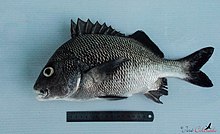Are Margate Fish Good to Eat Updated
Are Margate Fish Good to Eat
| Black margate | |
|---|---|
 | |
| Scientific classification | |
| Kingdom: | Animalia |
| Phylum: | Chordata |
| Class: | Actinopterygii |
| Guild: | Perciformes |
| Family unit: | Haemulidae |
| Genus: | Anisotremus |
| Species: | A. surinamensis |
| Binomial name | |
| Anisotremus surinamensis (Bloch, 1791) | |
| Synonyms [2] | |
| |
The black margate (Anisotremus surinamensis), also known equally black bream, black thicklip, dogfish, lippe, Mexican balderdash, pompon, Spanish grunt, surf bream, sweetlips or thicklip grunt, [3] is a species of marine ray-finned fish, a grunt belonging to the family Haemulidae. It is native to the western Atlantic Ocean. [ii]
Description [ edit ]
The black margate has a deep, compressed body with a loftier dorsum and a short, blunt head. The mouth is positioned low on the head, it is horizontal with fleshy lips and the jaws are equipped with bands of teeth on both jaws. The outer band of teeth are conical in shape. [4] Information technology has a greyish-siver trunk which is darker on the inductive half than the posterior half. The dorsal scales have blackness centres and the fins are night grayness, the pelvic and anal fins beingness the darkest. [five] There is a darker pt h to the rear of the pectoral fins. [6] The juveniles have a black stripe forth the lateral line and another forth the upper back, and a big black spot on base of tail fin. [iv] the dorsal fin has 12 spines and 18 soft rays while the anal fin contains three spines and 9 soft rays. [2] There is a deep notch in the dorsal fin and the quaternary dorsal spine is longer than the others while the second anal spine is too very large. [iv] The black margate reaches a maximum full length of 76 cm (30 in), although a total length of 45 cm (18 in) is more typical, while the heaviest specimen recorded was 5.viii kg (13 lb). [2]
Distribution [ edit ]
The black margate is found in the warmer parts of the Western Atlantic Sea. It is establish in Florida from Greatcoat Canaveral southward through the Florida Keys to the Gulf of Mexico, including the Flower Garden Banks, from Rockport, Texas forth the coast of Mexico to the northern Yucatan Peninsula and northwestern Cuba. It occurs throughout the Caribbean Bounding main then and forth the northern and eastern coasts of Due south America to Rio de Janeiro in Brazil. It as well occurs at the Fernando de Noronha and Trinidade Island. [1]
Habitat and biological science [ edit ]
The Black margate shows a preference for steep, sloping rock substrates or rock reefs in inshore waters downward to depths of 20 k (66 ft). It oft takes shelter in caves, ledges and within wrecks. It is normally encountered either as small groups or individuals. It is a nocturnal feeder, it's diet including crustaceans, molluscs, smaller fish and urchins. [6] A frequent particular in its diet are sea urchins in the genus Diadema . [two] They may gather in spawning aggregations and, off Jamaica, breeding adults have been reported between April and August. Larvae and young juveniles have been observed settling on rocky seabed's off Florida. [1]
Systematics [ edit ]
The black margate was first formally described in 1791 as Lutjanus surinamensis by the High german naturalist Marcus Elieser Bloch (1723–1799) with the blazon locality given as Suriname. [seven]
Utilisation [ edit ]
The black margate is occasionally defenseless and marketed by fisheries, although the consumption of the flesh of larger fishes has been linked to cases of ciguatera poisoning. They are also plant in the aquarium trade. [one]
References [ edit ]
- ^ a b c d Lindeman, Thou.; Anderson, W.; Claro, R.; Padovani-Ferreira, B.; Rocha, L.A.; Sedberry, Thousand. (2016). "Anisotremus surinamensis". IUCN Blood-red List of Threatened Species . 2016: e.T194408A2332935. doi: x.2305/IUCN.UK.2016-1.RLTS.T194408A2332935.en . Retrieved 20 November 2021.
- ^ a b c d e Froese, Rainer; Pauly, Daniel (eds.) (2019). "Anisotremus surinamensis " in FishBase. December 2019 version.
- ^ "Blackness Margate (Anisotremus surinamensis)". Whasthatfish . Retrieved 22 March 2019.
- ^ a b c "Species: Anisotremus surinamensis, Black margate". Shorefishes of the Greater Caribbean online data. Smithsonian Tropical Research Institute. Retrieved 22 March 2021.
- ^ MJ de Kluijver; G Gijswijt; I Da Cunda & R De Leon. "Black margate (Anisotremus surinamensis)". Interactive Guide to Caribbean Diving. Marine Species Identification Portal. Retrieved 17 March 2021.
- ^ a b "Black Margate". mexican-Fish.com . Retrieved 22 March 2021.
- ^ Eschmeyer, William N.; Fricke, Ron & van der Laan, Richard (eds.). "Species in the genus Anisotremus". Itemize of Fishes . California Academy of Sciences . Retrieved 22 March 2021.
External links [ edit ]
- Marinespecies.org
- Photos of Black margate on Sealife Drove
Are Margate Fish Good to Eat
Posted by: sullivanscerfumfor.blogspot.com

0 Response to "Are Margate Fish Good to Eat Updated"
Post a Comment